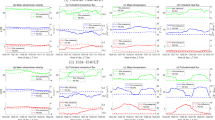Abstract
A new method is proposed for the effective roughness length (ERL) in heterogeneous terrain based on the principle of equalisation of momentum or heat fluxes calculated by the drag coefficient parameterization scheme used in the ECMWF numerical model. Compared with the area-weighted logarithmically averaged ERL (drag coefficient), the newly calculated ERL (drag coefficient) is about 40% (16%) larger with a roughness step of 2.3. These differences reach their maximum values when the ratio of smooth to rough surface is 60% to 40%. Since the determination by this method is not sensitive to the atmospheric stratification, it is suitable for use in climate models.
Similar content being viewed by others
References
Andre, J. C., and C. Blondin, 1980: On the effective roughness length for use in numerical three-dimensional models. Bmmi.-Laycr Meteor., 35, 231–245.
Hasager, C. B., and N. O. Jensen, 1999: Surface-flux aggregation in heterogeneous terrain. Quart. J. Roy. Meteor. Soc., 125, 2078–2102.
Henderson-Sellere, A., and A. J. Pitman, 1992: Land-surface schemes for future climate models: Specification, aggregation, and heterogeneity. J. Geophys. Res., 97 D3, 2687–2696.
Holtslag, A. A. M., and A. C. M. Bcljaars, 1989: Surface flux parameterization schemes: Developments and experiences at KNMI. Proceedings of the EOMWF Workshop on Parameterization of Fluxes over Land Surface, ECMWF, Reading, UK, 121–147.
Kondo, J., and H. Yamazawa, 1986: Aerodynamic roughness over an inhomogeneous ground surface. Bound.-Layer Meteor., 35, 331–348.
Louis, J. K, M. Tiedtke, and J. F, Geleyn, 1982: A short history of the PBL-parameterizat.ion at ECMWF. Proceedings of ECMWF workshop on boundary layer parameterization, KCMWF, 59–79.
Mason, P. J., 1988: The formation of a really-averaged roughness lengths. Quart. J. Roy. Meteor. Soc, 114, 399–420.
Schmid, H. P., and B. Bunzli, 1995: The influence of surface texture on the effective roughness length. Quart. J. Roy. Meteor. Soc, 121, 1–21.
Taylor, P. A., 1987: Comments and further analysis of effective roughness lengths for use in numerical three-dimensional models. Bound.-Layer Meteor., 39, 403–418.
Vihma, T., and H. Savijarvi, 1991: On the effective roughness length for heterogeneous terrain. Quart. J. Roy. Meteor. Soc., 117, 399–407.
Wood, N., and P. J. Mason, 1991: The influence of static stability on the effective roughness lengths for momentum and heat transfer. Quart. J. Roy. Meteor. Soc., 117, 1025–1058.
Wang H. J., and Wang X. L., 1999: Principles and Methodology of Ecoboundary Layer. China Meteorological Press, Beijing, 211 pp. (in Chinese)
Zhong Z., Su B. K., and Zhao M., 2002: A new method for the calculation of effective roughness length in atmospheric numerical models. Progress in Natural Science, 12, 519–523. (in Chinese)
Author information
Authors and Affiliations
Corresponding author
Rights and permissions
About this article
Cite this article
Zhong, Z., Zhao, M., Su, B. et al. On the Determination and Characteristics of Effective Roughness Length for Heterogeneous Terrain. Adv. Atmos. Sci. 20, 71–76 (2003). https://doi.org/10.1007/BF03342051
Received:
Revised:
Published:
Issue Date:
DOI: https://doi.org/10.1007/BF03342051




